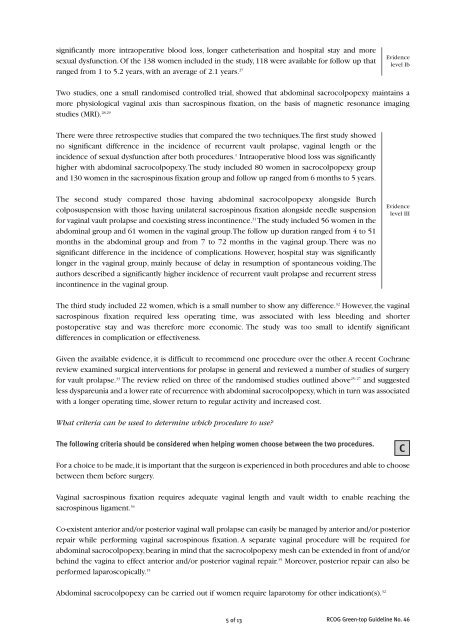The Management of Post Hysterectomy Vaginal Vault Prolapse ...
The Management of Post Hysterectomy Vaginal Vault Prolapse ...
The Management of Post Hysterectomy Vaginal Vault Prolapse ...
You also want an ePaper? Increase the reach of your titles
YUMPU automatically turns print PDFs into web optimized ePapers that Google loves.
significantly more intraoperative blood loss, longer catheterisation and hospital stay and moresexual dysfunction. Of the 138 women included in the study, 118 were available for follow up thatranged from 1 to 5.2 years, with an average <strong>of</strong> 2.1 years. 27Evidencelevel IbTwo studies, one a small randomised controlled trial, showed that abdominal sacrocolpopexy maintains amore physiological vaginal axis than sacrospinous fixation, on the basis <strong>of</strong> magnetic resonance imagingstudies (MRI). 28,29<strong>The</strong>re were three retrospective studies that compared the two techniques. <strong>The</strong> first study showedno significant difference in the incidence <strong>of</strong> recurrent vault prolapse, vaginal length or theincidence <strong>of</strong> sexual dysfunction after both procedures. 1 Intraoperative blood loss was significantlyhigher with abdominal sacrocolpopexy. <strong>The</strong> study included 80 women in sacrocolpopexy groupand 130 women in the sacrospinous fixation group and follow up ranged from 6 months to 5 years.<strong>The</strong> second study compared those having abdominal sacrocolpopexy alongside Burchcolposuspension with those having unilateral sacrospinous fixation alongside needle suspensionfor vaginal vault prolapse and coexisting stress incontinence. 31 <strong>The</strong> study included 56 women in theabdominal group and 61 women in the vaginal group. <strong>The</strong> follow up duration ranged from 4 to 51months in the abdominal group and from 7 to 72 months in the vaginal group. <strong>The</strong>re was nosignificant difference in the incidence <strong>of</strong> complications. However, hospital stay was significantlylonger in the vaginal group, mainly because <strong>of</strong> delay in resumption <strong>of</strong> spontaneous voiding. <strong>The</strong>authors described a significantly higher incidence <strong>of</strong> recurrent vault prolapse and recurrent stressincontinence in the vaginal group.Evidencelevel III<strong>The</strong> third study included 22 women, which is a small number to show any difference. 32 However, the vaginalsacrospinous fixation required less operating time, was associated with less bleeding and shorterpostoperative stay and was therefore more economic. <strong>The</strong> study was too small to identify significantdifferences in complication or effectiveness.Given the available evidence, it is difficult to recommend one procedure over the other. A recent Cochranereview examined surgical interventions for prolapse in general and reviewed a number <strong>of</strong> studies <strong>of</strong> surgeryfor vault prolapse. 33 <strong>The</strong> review relied on three <strong>of</strong> the randomised studies outlined above 25–27 and suggestedless dyspareunia and a lower rate <strong>of</strong> recurrence with abdominal sacrocolpopexy, which in turn was associatedwith a longer operating time, slower return to regular activity and increased cost.What criteria can be used to determine which procedure to use?<strong>The</strong> following criteria should be considered when helping women choose between the two procedures.For a choice to be made, it is important that the surgeon is experienced in both procedures and able to choosebetween them before surgery.<strong>Vaginal</strong> sacrospinous fixation requires adequate vaginal length and vault width to enable reaching thesacrospinous ligament. 34Co-existent anterior and/or posterior vaginal wall prolapse can easily be managed by anterior and/or posteriorrepair while performing vaginal sacrospinous fixation. A separate vaginal procedure will be required forabdominal sacrocolpopexy, bearing in mind that the sacrocolpopexy mesh can be extended in front <strong>of</strong> and/orbehind the vagina to effect anterior and/or posterior vaginal repair. 35 Moreover, posterior repair can also beperformed laparoscopically. 15CAbdominal sacrocolpopexy can be carried out if women require laparotomy for other indication(s). 325 <strong>of</strong> 13RCOG Green-top Guideline No. 46
















